Enzymatic Removal of Diclofenac and Aceclofenac from Water by Soybean Peroxidase
Abstract
1. Introduction
2. Results and Discussion
2.1. Effect of pH
2.2. Effect of SBP Activity
2.3. Hydrogen Peroxide Sensitivity
2.4. Reaction Times
2.5. Preliminary Product Identification Using Mass Spectrometry
3. Materials and Methods
3.1. Chemicals and Equipment
3.2. Enzyme Stock Solutions and Buffers
3.3. SBP Activity Assay
3.4. Experimental Protocols
4. Conclusions
Author Contributions
Funding
Institutional Review Board Statement
Informed Consent Statement
Data Availability Statement
Conflicts of Interest
References
- Rasheed, T.; Bilal, M.; Nabeel, F.; Adeel, M.; Iqbal, H.M.N. Environmentally related contaminants of high concern: Potential sources and analytical modalities for detection, quantification, and treatment. Environ. Int. 2019, 122, 52–66. [Google Scholar] [CrossRef]
- Parolini, M. Toxicity of the non-steroidal anti-inflammatory drugs (NSAIDs) acetylsalicylic acid, paracetamol, diclofenac, ibuprofen and naproxen towards freshwater invertebrates: A review. Sci. Total Environ. 2020, 740, 140043. [Google Scholar] [CrossRef]
- Cooper, C.; Chapurlat, R.; Al-Daghri, N.; Herrero-Beaumont, G.; Bruyère, O.; Rannou, F.; Roth, R.; Uebelhart, D.; Reginster, J.Y. Safety of oral non-selective non-steroidal anti-inflammatory drugs in osteoarthritis: What does the literature say? Drugs Aging Drugs Aging 2019, 36 (Suppl. S1), 15–24. [Google Scholar] [CrossRef]
- Carmona, E.; Andreu, V.; Picó, Y. Occurrence of acidic pharmaceuticals and personal care products in Turia River Basin: From waste to drinking water. Sci. Total Environ. 2014, 484, 53–63. [Google Scholar] [CrossRef]
- De Jesus Silva Chaves, M.; Barbosa, S.C.; De Melo Malinowski, M.; Volpato, D.; Castro, Í.B.; Franco, T.C.; Primel, E.G. Pharmaceuticals and personal care products in a Brazilian wetland of international importance: Occurrence and environmental risk assessment. Sci. Total Environ. 2020, 734, 139374. [Google Scholar] [CrossRef]
- Eslami, A.; Amini, M.M.; Yazdanbakhsh, A.R.; Rastkari, N.; Mohseni-Bandpei, A.; Nasseri, S.; Piroti, E.; Asadi, A. Occurrence of non-steroidal anti-inflammatory drugs in Tehran source water, municipal and hospital wastewaters, and their ecotoxicological risk assessment. Environ. Monit. Assess. 2015, 187, 734. [Google Scholar] [CrossRef]
- Gumbi, B.P.; Moodley, B.; Birungi, G.; Ndungu, P.G. Detection and quantification of acidic drug residues in South African surface water using gas chromatography-mass spectrometry. Chemosphere 2017, 168, 1042–1050. [Google Scholar] [CrossRef]
- K’oreje, K.O.; Vergeynst, L.; Ombaka, D.; De Wispelaere, P.; Okoth, M.; Van Langenhove, H.; Demeestere, K. Occurrence patterns of pharmaceutical residues in wastewater, surface water and groundwater of Nairobi and Kisumu city, Kenya. Chemosphere 2016, 149, 238–244. [Google Scholar] [CrossRef]
- You, L.; Nguyen, V.T.; Pal, A.; Chen, H.; He, Y.; Reinhard, M.; Gin, K.Y.H. Investigation of pharmaceuticals, personal care products and endocrine disrupting chemicals in a tropical urban catchment and the influence of environmental factors. Sci. Total Environ. 2015, 536, 955–963. [Google Scholar] [CrossRef]
- Riva, S. Laccases: Blue enzymes for green chemistry. Trends Biotechnol. 2006, 24, 219–226. [Google Scholar] [CrossRef]
- Pérez, S.; Barceló, D. First Evidence for Occurrence of Hydroxylated Human Metabolites of Diclofenac and Aceclofenac in Wastewater Using QqLIT-MS and QqTOF-MS. Anal. Chem. 2008, 80, 8135–8145. [Google Scholar] [CrossRef]
- Rout, P.R.; Zhang, T.C.; Bhunia, P.; Surampalli, R.Y. Treatment technologies for emerging contaminants in wastewater treatment plants: A review. Sci. Total Environ. 2021, 753, 141990. [Google Scholar] [CrossRef] [PubMed]
- Kwak, K.; Ji, K.; Kho, Y.; Kim, P.; Lee, J.; Ryu, J.; Choi, K. Chronic toxicity and endocrine disruption of naproxen in freshwater waterfleas and fish, and steroidogenic alteration using H295R cell assay. Chemosphere 2018, 204, 156–162. [Google Scholar] [CrossRef]
- Pandelides, Z.; Ussery, E.J.; Overturf, M.D.; Guchardi, J.; Holdway, D.A. Inhibition of swim bladder inflation in Japanese medaka (Oryzias latipes) embryos following exposure to select pharmaceuticals alone and in combination. Aquat. Toxicol. 2021, 234, 105796. [Google Scholar] [CrossRef]
- Xiong, Q.; Liu, Y.S.; Hu, L.X.; Shi, Z.Q.; Ying, G.G. Levofloxacin and sulfamethoxazole induced alterations of biomolecules in Pseudokirchneriella subcapitata. Chemosphere 2020, 253, 126722. [Google Scholar] [CrossRef]
- Steevensz, A.; Madur, S.; Feng, W.; Taylor, K.E.; Bewtra, J.K.; Biswas, N. Crude soybean hull peroxidase treatment of phenol in synthetic and real wastewater: Enzyme economy enhanced by Triton X-100. Enzym. Microb. Technol. 2014, 55, 65–71. [Google Scholar] [CrossRef]
- Ćirić-Marjanović, G.; Milojević-Rakić, M.; Janošević-Ležaić, A.; Luginbühl, A.; Walde, P. Enzymatic oligomerization and polymerization of arylamines: State of the art and perspectives. Chem. Pap. 2017, 71, 199–242. [Google Scholar] [CrossRef]
- Saha, B.; Taylor, K.E.; Bewtra, J.K.; Biswas, N. Laccase-catalyzed removal of diphenylamine from synthetic wastewater. Water Environ. Res. 2008, 80, 2118–2124. [Google Scholar] [CrossRef]
- Wang, M.; Fang, L. Percutaneous absorption of diclofenac acid and its salts from emulgel. Asian J. Pharm. Sci. 2008, 3, 131–141. [Google Scholar]
- De Rossi, A.; Rigueto, C.V.T.; Dettmer, A.; Colla, L.M.; Piccin, J.S. Synthesis characterization application of Saccharomyces cerevisiae/alginate composites beads for adsorption of heavy metals. J. Environ. Chem. Eng. 2020, 8, 104009. [Google Scholar] [CrossRef]
- Jodeh, S.; Basalat, N.; Obaid, A.; Bouknana, D.; Hammouti, B.; Hadda, T.; Jodeh, W.; Warad, I. Adsorption of some organic phenolic compounds using activated carbon from cypress products. J. Chem. Pharm. Res. 2014, 6, 713–723. [Google Scholar]
- Urrea, D.A.; Haure, P.M.; Einschlag, F.S.; Contreras, E.M. Horseradish peroxidase-mediated decolourization of Orange II: Modelling hydrogen peroxide utilization efficiency at different pH values. Environ. Sci. Pollut. Res. Int. 2018, 25, 19989–20002. [Google Scholar] [CrossRef]
- Kamal, J.A.; Behere, D.V. Activity, stability and conformational flexibility of seed coat soybean peroxidase. J. Inorg. Biochem. 2003, 94, 236–242. [Google Scholar] [CrossRef]
- Mousa Al-Ansari, M.; Steevensz, A.; Al-Aasm, N.; Taylor, K.E.; Bewtra, J.K.; Biswas, N. Soybean peroxidase-catalyzed removal of phenylenediamines and benzenediols from water. Enzyme Microb. Technol. 2009, 45, 253–260. [Google Scholar] [CrossRef]
- Altahir, B.M.; Feng, W.; Jasim, H.H.; Taylor, K.E.; Biswas, N.; Bewtra, J.K.; Jassim, S.A. Soybean peroxidase-catalysed removal of benzidines from water. J. Environ. Eng. Sci. 2016, 10, 73–80. [Google Scholar] [CrossRef]
- Mukherjee, D.; Taylor, K.E.; Biswas, N. Soybean Peroxidase-Induced treatment of Dye-Derived arylamines in water. Water Air Soil Pollut. 2018, 229, 283. [Google Scholar] [CrossRef]
- Lloret, L.; Eibes, G.; Moreira, M.T.; Feijoo, G.; Lema, J.M. On the use of a high-redox potential laccase as an alternative for the transformation of non-steroidal anti-inflammatory drugs (NSAIDs). J. Mol. Catal. B Enzym. 2013, 97, 233–242. [Google Scholar] [CrossRef]
- Rahman, M.; Ullah, M.W.; Shah, J.A.; Sethupathy, S.; Bilal, H.; Abdikakharovich, S.A.; Khan, A.U.; Khan, K.A.; Elboughdiri, N.; Zhu, D. Harnessing the power of bacterial laccases for xenobiotic degradation in water: A 10-year overview. Sci. Total Environ. 2024, 918, 170498. [Google Scholar] [CrossRef]
- Mukherjee, D.; Bhattacharya, S.; Taylor, K.E.; Biswas, N. Enzymatic treatment for removal of hazardous aqueous arylamines, 4,4′-methylenedianiline and 4,4′-thiodianiline. Chemosphere 2019, 235, 365–372. [Google Scholar] [CrossRef] [PubMed]
- Patapas, J.; Mousa Al-Ansari, M.; Taylor, K.E.; Bewtra, J.K.; Biswas, N. Removal of dinitrotoluenes from water via reduction with iron and peroxidase-catalyzed oxidative polymerization: A comparison between Arthromyces ramosus peroxidase and soybean peroxidase. Chemosphere 2007, 67, 1485–1491. [Google Scholar] [CrossRef] [PubMed]
- Bódalo, A.; Gómez, E.; Gómez, J.L.; Bastida, J.; Máximo, M.F.; Díaz, F. A comparison of different methods of β-galactosidase immobilization. Process Biochem. 1991, 26, 349–353. [Google Scholar] [CrossRef]
- Mashhadi, N.; Taylor, K.E.; Biswas, N.; Meister, P.; Gauld, J.W. Oligomerization of 3-substituted quinolines by catalytic activity of soybean peroxidase as a wastewater treatment. Product formation and computational studies. Chem. Eng. J. 2019, 364, 340–348. [Google Scholar] [CrossRef]
- Zhang, X. Enzymatic Treatment of Selected Pesticides in Aqueous System. Master’s Thesis, University of Windsor, Windsor, ON, Canada, 2019. [Google Scholar]
- Ziayee Bideh, N.; Mashhadi, N.; Taylor, K.E.; Biswas, N. Elimination of selected heterocyclic aromatic emerging contaminants from water using soybean peroxidase. Environ. Sci. Pollut. Res. 2021, 28, 37570–37579. [Google Scholar] [CrossRef]
- Sharifzadeh, M.; Narimannejad, S.; Taylor, K.E.; Biswas, N. Enzymatic removal of the sulfa drugs sulfamethoxazole and sulfamerazine from synthetic wastewater by soybean peroxidase. Environ. Sci. Pollut. Res. 2024, 31, 64760–64771. [Google Scholar] [CrossRef]
- Mashhadi, N.; Taylor, K.E.; Biswas, N.; Meister, P.; Gauld, J.W. Biocatalytic oligomerization of azoles; experimental and computational studies. Environ. Sci. Water Res. Technol. 2021, 7, 1103–1113. [Google Scholar] [CrossRef]
- Mukherjee, D.; Taylor, K.E.; Biswas, N. Soybean peroxidase-catalyzed oligomerization of arylamines in water: Optimization, kinetics, products and cost. J. Environ. Chem. Eng. 2020, 8, 103871. [Google Scholar] [CrossRef]
- Cordova Villegas, L.G.; Mashhadi, N.; Chen, M.; Mukherjee, D.; Taylor, K.E.; Biswas, N. A short review of techniques for phenol removal from wastewater. Curr. Pollut. Rep. 2016, 2, 157–167. [Google Scholar] [CrossRef]
- Kaur, A.; Taylor, K.E.; Biswas, N. Soybean peroxidase-catalyzed degradation of a sulfonated dye and its azo-cleavage product. J. Chem. Technol. Biotechnol. 2020, 96, 423–430. [Google Scholar] [CrossRef]
- Dec, J.; Bollag, J.M. Dehalogenation of chlorinated phenols during oxidative coupling. Environ. Sci. Technol. 1994, 28, 484–490. [Google Scholar] [CrossRef]
- Bollag, J.M.; Liu, S.Y.; Minard, R.D. Asymmetric diphenol formation by a fungal laccase. Appl. Environ. Microbiol 1979, 38, 90–92. [Google Scholar] [CrossRef]
- Yu, J.; Taylor, K.E.; Zou, H.; Biswas, N.; Bewtra, J.K. Phenol conversion and dimeric intermediates in horseradish peroxidase-catalyzed phenol removal from water. Environ. Sci. Technol. 1994, 28, 2154–2160. [Google Scholar] [CrossRef]
- Gomori, G. [16] Preparation of buffers for use in enzyme studies. In Methods in Enzymology; Colowick, S.P., Kaplan, N.O., Eds.; Academic Press: New York, NY, USA, 1955; Volume 1, pp. 138–146. [Google Scholar] [CrossRef]
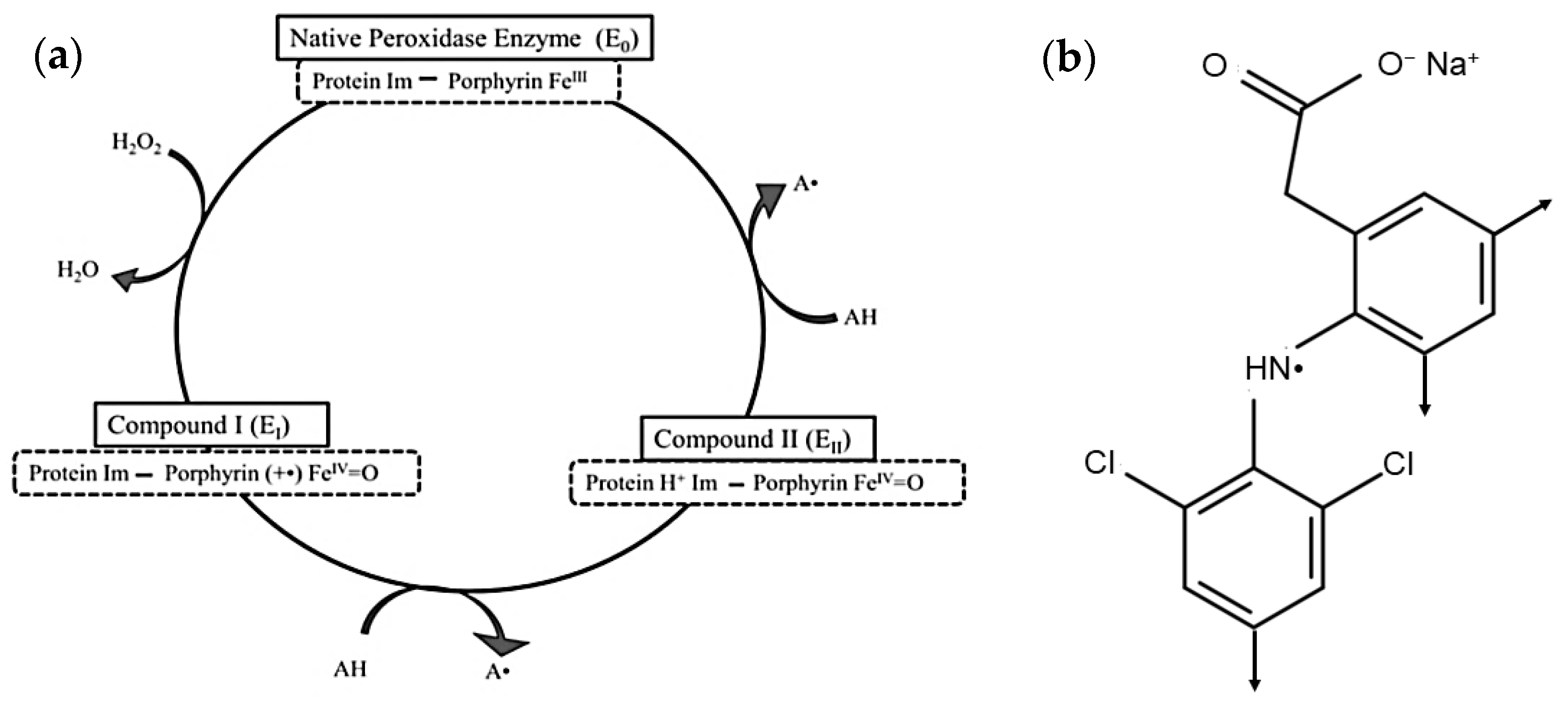
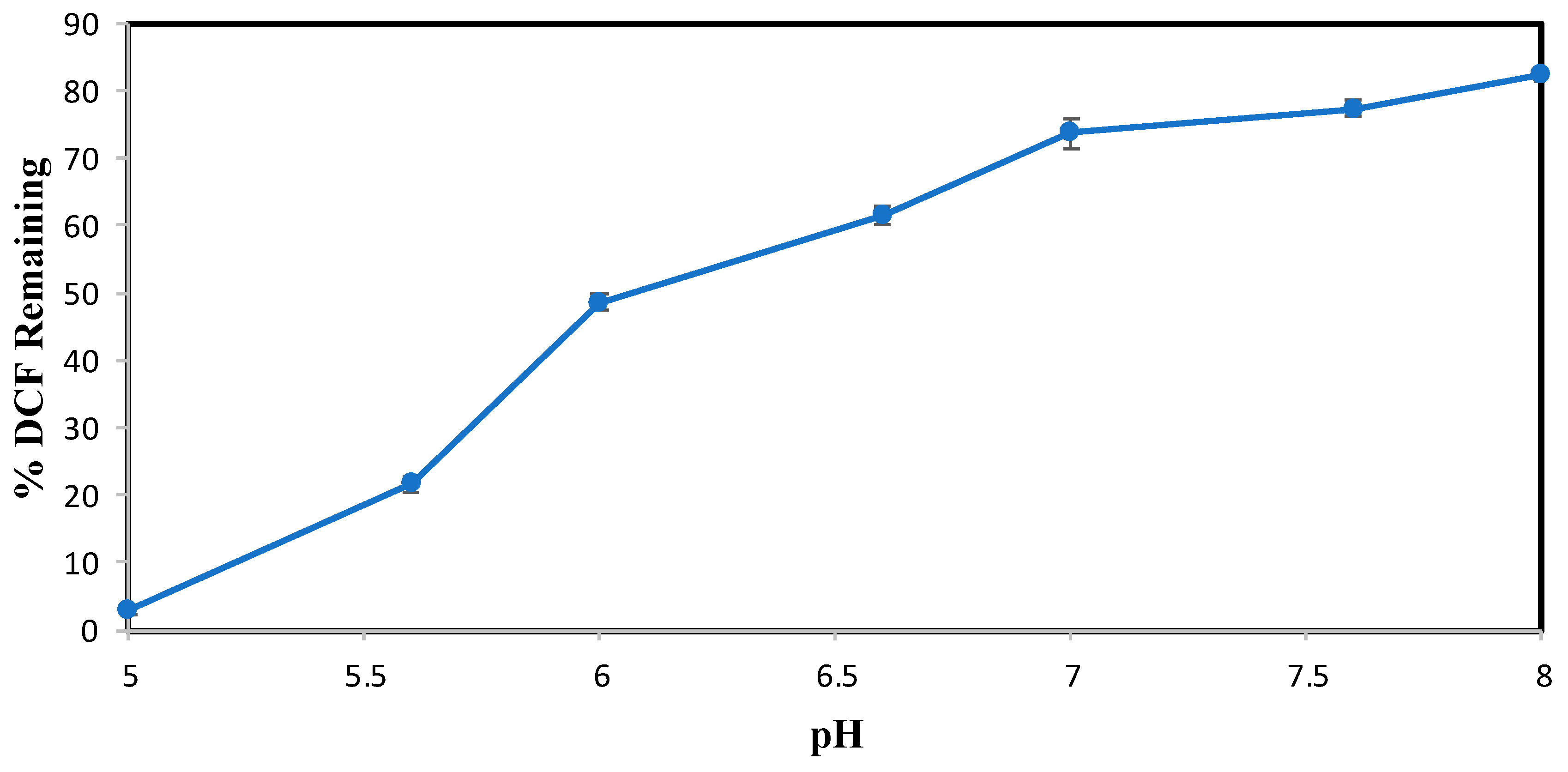
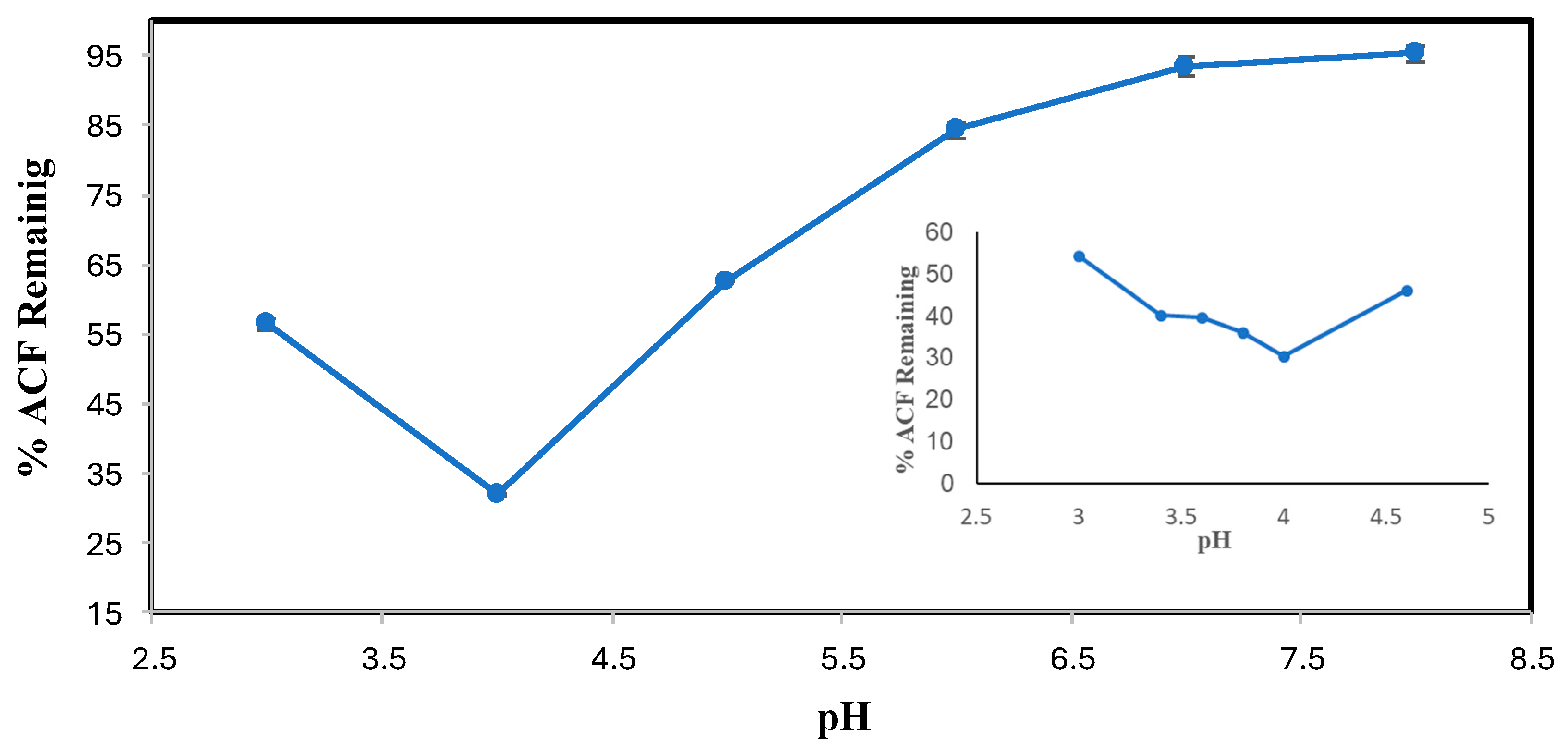
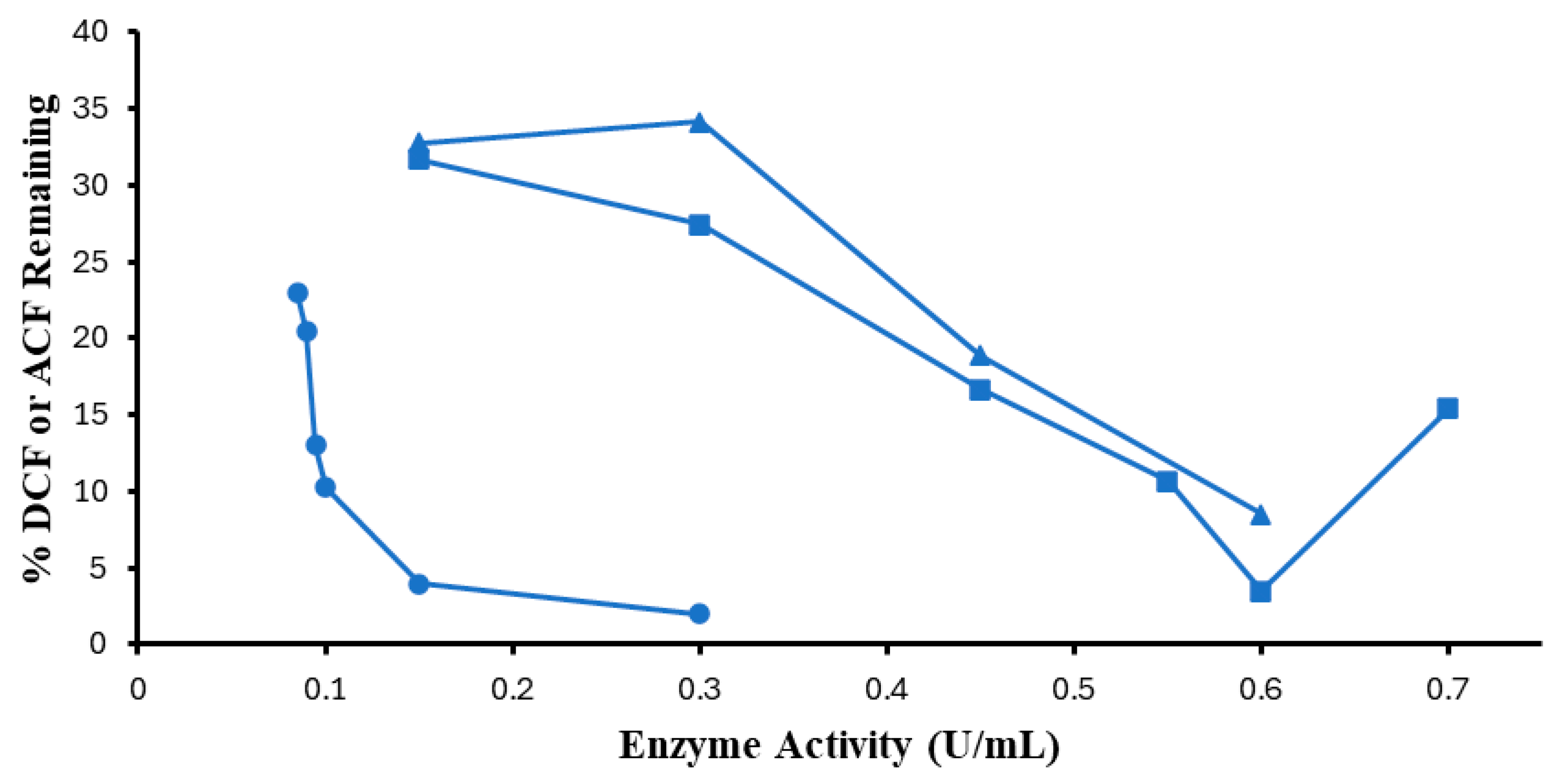
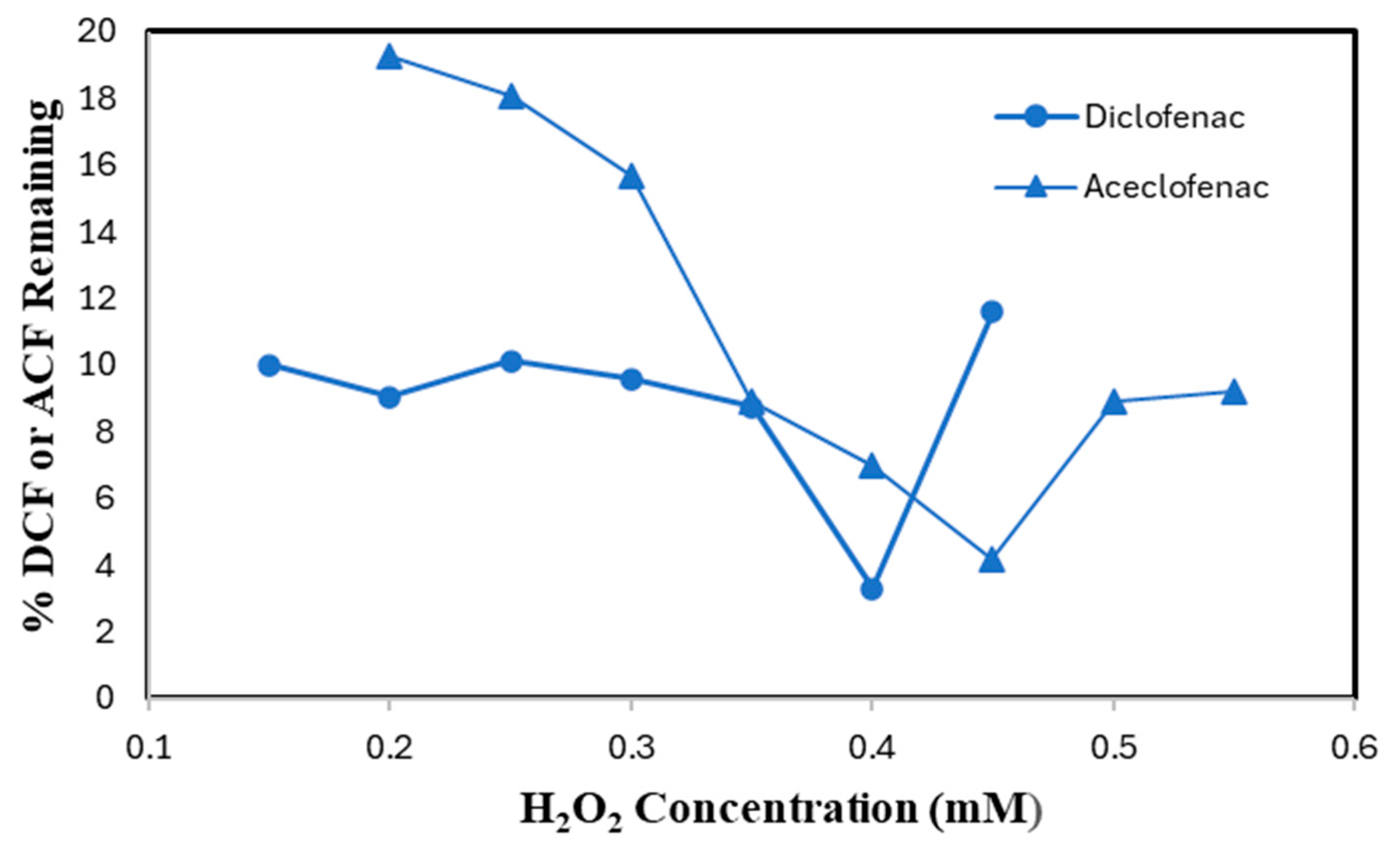

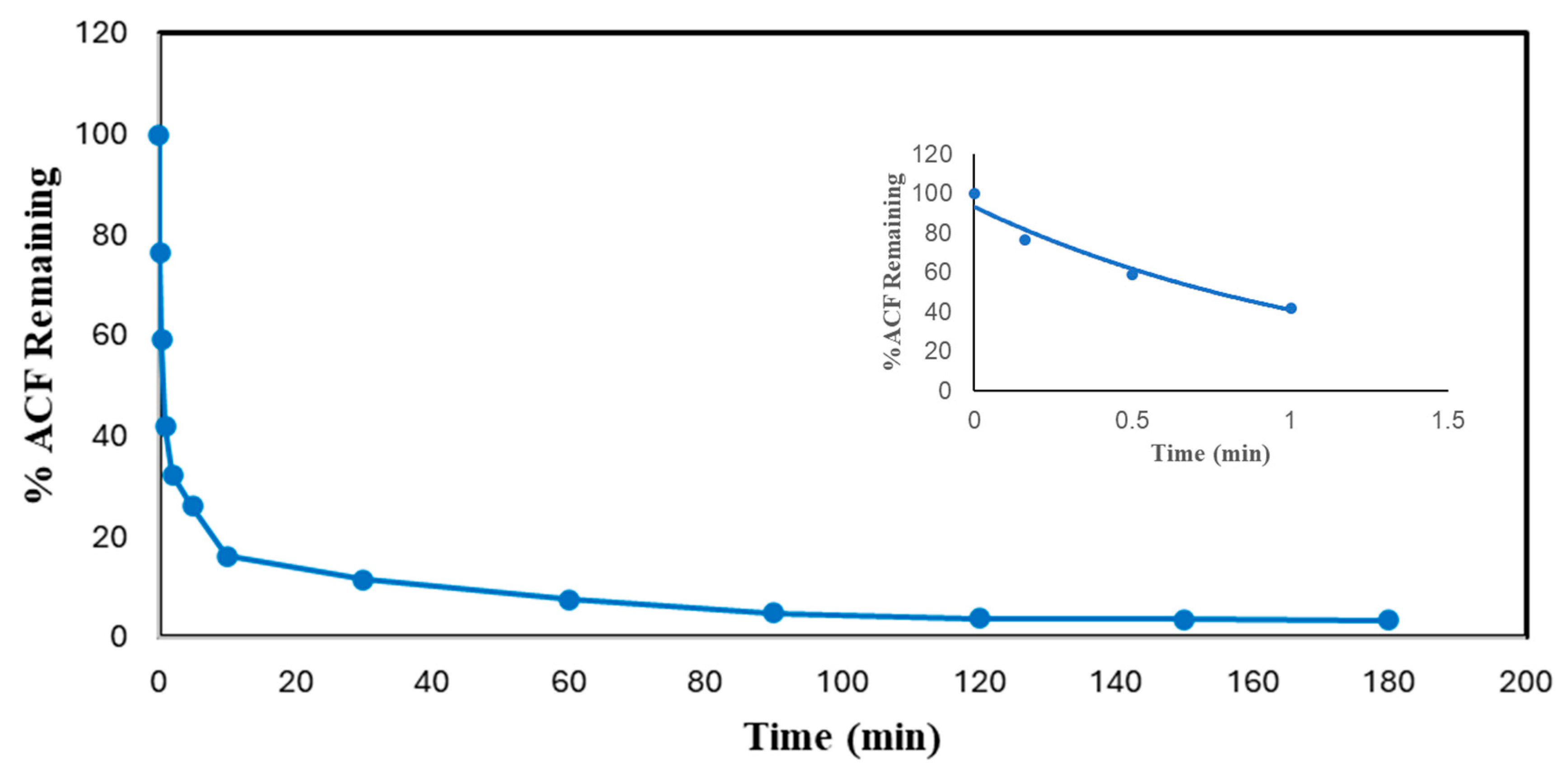
| Reference | Substrate | Half-Life (min) | Normalized Half-Life (min.U/mL) | |
|---|---|---|---|---|
| Present Study | - | DCF | 1.43 ± 0.01 | 0.22 ± 0.02 |
| ACF | 0.84 ± 0.05 | 0.49 ± 0.01 | ||
| Sulfa Drugs | [35] | Sulfamethoxazole | 0.804 ± 0.003 | 0.0804 ± 0.0003 |
| Sulfamerazine | 1.22 ± 0.01 | 0.061 ± 0.008 | ||
| HACs † | [36] | Pyrrole | 49.2 ± 3.0 | 246 ± 15 |
| Indole | 25.2 ± 1.2 | 11.3 ± 0.5 | ||
| 2-Aminothiazole | 33.0 ± 0.6 | 132 ± 2 | ||
| 2-Aminobenzothiazole | 720 ± 0.01 | 3240 ± 0.0 | ||
| 4-Aminoantipyrine | 60.6 ± 1.2 | 6.06 ± 0.12 | ||
| Hydroxybenzotriazole | 41.4 ± 1.8 | 4.97 ± 0.22 | ||
| 2-Aminoimidazole | 5.1 ± 0.2 | 7.7 ± 0.3 | ||
| 2-Amino-benzimidazole | 29.4 ± 0.6 | 88.2 ± 1.8 | ||
| 3-Aminopyrazole | 36.0 ± 1.2 | 108 ± 4 | ||
| [32] | 3-Hydroxyquinoline | 11.9 ± 0.6 | 1.19 ± 0.06 | |
| 3-Aminoquinoline | 15.0 ± 0.6 | 67.5 ± 2.7 | ||
| Arylamines | [37] | 4,4′-Methylenebis (2-chlororaniline) | 4.08 ± 0.02 | 0.408 ± 0.002 |
| 4-Chloro-o-toluidine | 11.5 ± 0.0 | 0.104 ± 0.0 | ||
| [26] | p-Cresidine | 1.80 ± 0.02 | 0.072 ± 0.001 | |
| 4,4′-Oxydianiline | 12.4 ± 0.0 | 0.124 ± 0.0 | ||
| [29] | 4,4′-Thiodianiline | 0.513 ± 0.007 | 0.0770 ± 0.0011 | |
| 4,4′-Methylene-dianiline | 0.58 ± 0.10 | 0.40 ± 0.07 | ||
| Pesticides | [33] | Bromoxynil | 3.00 ± 0.13 | 2.7 ± 0.02 |
| Ioxynil | 0.51 ± 0.018 | 0.18 ± 0.01 | ||
| Azo dyes | [38] | CI Acid Blue 113 | 8.8 ± 0.60 | 13.2 ± 0.9 |
| CI Direct Black 38 | 2.1 ± 0.2 | 6.4 ± 0.6 | ||
| Heteroaromatics | [34] | 3-Hydroxycoumarin | 12.4 ± 0.5 | 0.0257 ± 0.0010 |
| 2-Aminobenzoxazole | 129 ± 4 (0.44) | 452 ± 15 | ||
| Dyes | [39] | p-Anisidine | 5.46 ± 0.84 | 0.0097 ± 0.0011 |
| CI Methyl Orange | 7 ± 2 | 0.048 ± 0.010 |
| Standard | Symbol | Molecular Formula | m/z | Detected |
|---|---|---|---|---|
| DCF | MH | C14H11Cl2NNaO2 | 318.00646 | * |
| M | C14H10Cl2NNaO2 | 316.99863 | ||
| Identified products | MH-Na+H | C14H12Cl2NO2 | 296.02451 | * |
| M2H-2 | C28H18Cl4N2Na2O4 | 631.98161 | ||
| M3H-4 | C42H26Cl6N3Na3O6 | 946.96459 | ||
| M4H-6 | C56H34Cl8N4Na4O8 | 1261.94757 | * | |
| M4H-6-4Na+H | C56H35Cl8N4O8 | 1170.99631 | * | |
| M4H-6-3Cl | C56H34Cl5N4O8 | 1065.08193 | * |
Disclaimer/Publisher’s Note: The statements, opinions and data contained in all publications are solely those of the individual author(s) and contributor(s) and not of MDPI and/or the editor(s). MDPI and/or the editor(s) disclaim responsibility for any injury to people or property resulting from any ideas, methods, instructions or products referred to in the content. |
© 2025 by the authors. Licensee MDPI, Basel, Switzerland. This article is an open access article distributed under the terms and conditions of the Creative Commons Attribution (CC BY) license (https://creativecommons.org/licenses/by/4.0/).
Share and Cite
Pishyar, S.; Narimannejad, S.; Taylor, K.E.; Biswas, N. Enzymatic Removal of Diclofenac and Aceclofenac from Water by Soybean Peroxidase. Molecules 2025, 30, 1817. https://doi.org/10.3390/molecules30081817
Pishyar S, Narimannejad S, Taylor KE, Biswas N. Enzymatic Removal of Diclofenac and Aceclofenac from Water by Soybean Peroxidase. Molecules. 2025; 30(8):1817. https://doi.org/10.3390/molecules30081817
Chicago/Turabian StylePishyar, Sara, Samira Narimannejad, Keith E. Taylor, and Nihar Biswas. 2025. "Enzymatic Removal of Diclofenac and Aceclofenac from Water by Soybean Peroxidase" Molecules 30, no. 8: 1817. https://doi.org/10.3390/molecules30081817
APA StylePishyar, S., Narimannejad, S., Taylor, K. E., & Biswas, N. (2025). Enzymatic Removal of Diclofenac and Aceclofenac from Water by Soybean Peroxidase. Molecules, 30(8), 1817. https://doi.org/10.3390/molecules30081817







